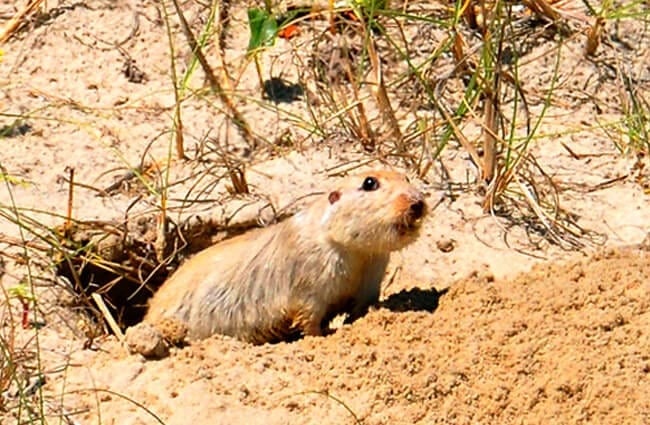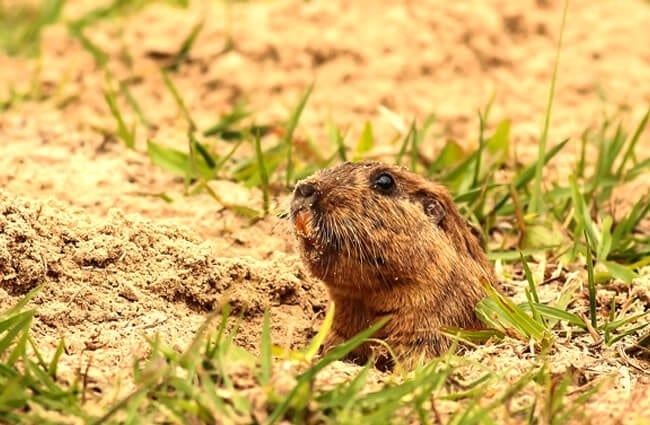The Tuco Tuco, also known as the Tuco-Tuco, is a small rodent that lives in South America. They are similar to the North American gopher. Researchers place them in the taxonomic genus Ctenomys. Some of their closest relatives include the degu, rock rat, and the vizcacha rat. Read on to learn about the Tuco Tuco.
Description of the Tuco Tuco
These rodents are relatively small. They are rat-like in appearance, with long tails, but they have broad heads. Their front limbs also have long claws to tunnel beneath the ground.
Researchers recognize at least 38 different species, and each is slightly different from the next. Their fur is typically brown or black. Most individuals measure between 8 and 14 in. long, and weigh about 1 lb.
Interesting Facts About the Tuco Tuco
These little South American rodents have a number of different traits and adaptations to help them survive. Learn more about the various species below.
- Wrinkle-Rat – These creatures have surprisingly loose and flexible skin. This allows them to crawl through tight spaces and navigate their burrows with ease.
- Tunnel Shovel – When digging their burrows, these rodents actually use their long front teeth to scrape out dirt or sand. Once they push the soil out of the way with their teeth, they use their rear legs to shove it backwards out of the tunnel.
- What’s in a Name? – This species is actually named for its distinct call. When alarmed, these creatures give out a “Tuco-Tuco!” call. This behavior is most common in social species.
- The More the Merrier – Like the gopher tortoise, these creatures’ burrows support a variety of other animals. Many different small mammals, snakes, lizards, and toads all take shelter in their burrows.
Habitat of the Tuco Tuco
While each species is different, they all live primarily underground. These rodents prefer habitats with soft sands or similar soils. Many species live in mountainous regions at high elevations. Each species has its own unique and specific habitat preferences.
Distribution of the Tuco Tuco
All of the different species live in South America. Each has its own unique range and distribution. Some live across vast regions, while others live only in a small area.
You can find them primarily in the southern and central regions of South America. These rodents live in Peru, Brazil, Bolivia, Paraguay, Uruguay, Chile, and Argentina.
Diet of the Tuco Tuco
This mammal spends the vast majority of its time underground. Thus, you shouldn’t be surprised that it also feeds underground as well!
These creatures eat a wide variety of vegetation. They burrow underground, searching for roots, tubers, and other underground plant parts. When it does emerge from its burrow, it munches on the grass in close proximity to the entrance.
Tuco Tuco and Human Interaction
Humans do not directly interact with these rodents most of the time. These creatures do sometimes damage crops, and their burrows pose a tripping hazard to livestock. Conversely, humans destroy their sparse habitat for agricultural purposes.
The impact of human activity on these creatures varies from one species to the next. In some, researchers simply don’t have enough information to assess the population.
Domestication
Humans have not domesticated this rodent in any way.
Does the Tuco Tuco Make a Good Pet
No, these animals do not make good pets. They spend most of their time underground, so you wouldn’t see them very frequently!
Tuco Tuco Care
These little mammals are not the most popular attraction in zoos. Thus, it is difficult for you to find zoological specimens, and difficult to know what their care entails. Because they live underground, zoos must provide substrate for them to burrow in, or artificial tunnels to explore.
Zookeepers would likely provide a variety of vegetables for them to eat, as well as grasses and hay. A veterinarian would recommend any additional supplements.
Behavior of the Tuco Tuco
Each species has slightly different behavior, but they all live in underground burrows. Oftentimes, many burrows lie in close proximity to one another. However, this is usually not for social reasons, but because usable habitat is difficult to find.
Some species live solitary lives, and only share their burrows with their offspring. Other species live in small colonies with several individuals.
Reproduction of the Tuco Tuco
Like social behavior, breeding habits vary from species to species as well. Their breeding season, and the number of litters that they produce in a year, changes based on the species at hand.
Most females give birth to a litter of three or four pups. The gestation period lasts about three months. It takes just a month for the mother to wean the young, and by the time they are two months old the pups are fully independent. They reach sexual maturity when they are about nine months old.





![Red Angus Closeup of a beautiful Red Angus cowPhoto by: U.S. Department of Agriculture [pubic domain]https://creativecommons.org/licenses/by/2.0/](https://animals.net/wp-content/uploads/2020/03/Red-Angus-4-238x178.jpg)


![Red Angus Closeup of a beautiful Red Angus cowPhoto by: U.S. Department of Agriculture [pubic domain]https://creativecommons.org/licenses/by/2.0/](https://animals.net/wp-content/uploads/2020/03/Red-Angus-4-100x75.jpg)

